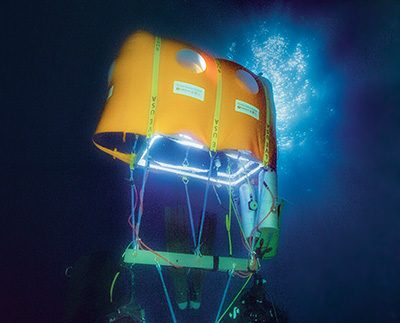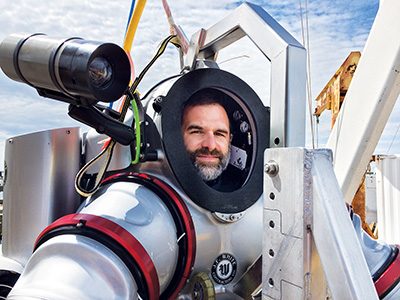Profil Peneliti
FISHING AND BEING ON THE WATER with family while growing up influenced Michael Lombardi to study marine biology. He and a friend got certified to dive during his junior year of high school, thinking it would be a useful tool for his desired field. Lombardi had no idea what professional diving meant or where it would take him.
After obtaining his certification, Lombardi flipped through the phone book and called multiple dive companies looking for a work opportunity. One asked if he was interested in cleaning boats, and he accepted, which led to him spending his summers doing hundreds of task-loaded dives.
With so much time spent underwater, this work set him well ahead of his peers. By the end of college, he had become a dive instructor, performed commercial dive work, and helped teach scientific diving. He decided to become a working diver, leading to more than 25 years in commercial diving, harbor service, construction and engineering work, and more. His interest in ocean exploration has created numerous opportunities benefiting from this working experience.
What do you love about diving?
There are always technical, operational, environmental, or physiological challenges, which led me to build and create different tools. Portable underwater habitats have been an important part of that.


How would you define an underwater habitat?
A habitat is a structure that creates a dry or semidry space for humans to enter and complete tasks underwater, whether sitting and decompressing, carrying out tests or science experiments, or eating and sleeping. It is a dry space created within the underwater environment.
How did your involvement in underwater habitats start?
In the early 2000s Win Burleson, a student at the Massachusetts Institute of Technology (MIT), was involved with space simulation and wrote an article in the MIT student newspaper about the concept of underwater camping, comparing it to what was already being used in space. It made me ask further why underwater habitats weren’t more attainable, so I reached out to him.
After a decade of various involvement with technical diving for science projects, I received funding from the National Geographic Society (NGS) in 2010 to test techniques for deep-diving work to more than 400 feet (122 meters). I learned that the pressure and stress of doing these very long decompression times of up to five hours is extremely taxing. That time could be more pleasant in an underwater habitat.
In 2012 we received a second round of funding to prototype a portable inflatable underwater habitat to address this time inefficiency. Later that year we completed designing and building our first-generation Ocean Space Habitat and securely anchored it in the Bahamas.
We did an exercise where we went on a sub-400-foot (122 meters) dive and spent our decompression time in the habitat rather than hang on a line for hours. We could look at the biological samples we had just collected, stay warm, and talk to each other rather than use hand signals. We made productive use of unproductive time.
That mission led to more deployments, with developmental progress and procedure refinement accompanying each one. In Rhode Island in 2018, we successfully deployed and anchored a habitat out of a pickup truck. Now two people can conveniently deploy the portable underwater habitat with all of its life support, supporting missions for up to several days without any significant infrastructure support, which is a stark contrast to the old habitat paradigm from half a century ago. I’ve shipped systems as far as Hong Kong for remote use.
How much time can a human spend in a portable habitat?
This was our challenge when we partnered with researchers from a Discovery Channel Shark Week program, The Great Hammerhead Stakeout. The researchers wanted a means to spend enough time in a habitat to observe environmental changes in a specific area through a full tidal cycle.
We established a dive protocol that allowed the team to spend 11-12 hours inside the habitat while they made five excursions out of the habitat up to 110 feet (33,5 meters) without incurring any required decompression. This achievement proved to me that there is a future for this technology that offers the gift of time.
By optimizing the coupling of rebreathers and habitats, divers can potentially spend multiple days underwater as an extension of today’s technical diving regimen and at a fraction of the cost of the saturation diving. Our 11- to 12-hour effort was a good start, but I wanted to make it possible to stay overnight in the habitat.
To do so, Burleson and I had to become comfortable with the system and enable it to carry enough life-support consumables, sustenance such as food and water, waste management items, and sources of warmth for a comfortable overnight stay. We conducted this experiment at the University of Arizona’s Biosphere 2 Ocean facility.
The next benchmark planned is a multiday event at a location yet to be determined. The concept of having multiple days available represents a paradigm shift where people can become part of the ocean ecosystem. We’re working with scientists who are just starting to consider the possibilities with that type of time routinely available to them.
What does habitat deployment look like?
We have built five systems, with each new one improving on the last. The exterior is comparable to a lift bag. The interior generally has seats, life-support hardware, structural framing, a workbench, and food and water supplies. It all collapses on itself when packing up, and two people can manage the whole package plus rigging.
A habitat that comfortably holds two people sitting at rest is 3,500 pounds (1.587,6 kilograms) buoyant, so to safely anchor it you need at least 3,500 pounds (1.587,6 kilograms) plus safety. Anchoring can take a couple of hours to a couple of days, and there are many ways to achieve it, all similar to techniques we use in commercial diving. The method depends on the environment, available resources, and infrastructure access.
We deploy the anchor first, and then two people can easily toss the habitat overboard. We designed and engineered the rigging to be straightforward, using hooks with shackles.
Tell us about some of your other projects.
I really enjoy deep reef diving for science and that feeling of conquering the abyss. Closer to home, I’m underwater almost every day and have done things from as mundane as scraping barnacles to as elaborate as diving in compost digestion tanks.
That thrill of discovery is what makes it all worthwhile. It’s not an experience you can buy — it happens only with time in the water. On one deep dive I was collecting cryptic fish for an ichthyologist, and one specimen turned out to be a new species. With new discoveries you typically get to choose between copublishing or naming the species. I had published plenty of papers, so I chose the name Derilissus lombardii. In another more recent instance, I stumbled upon what may be a very old submerged indigenous settlement here in Rhode Island. These accidental discoveries help move the life aquatic forward.
And then there are the technology projects. I design and build all of my own rebreather systems and together with partners have brought a unit to market. In 2013 I was invited to be one of the first trainees in the Nuytco Research Exosuit ADS. It’s a remarkable tool: an atmospheric suit with no water pressure on the operator, so a person could spend all day in it without having to decompress. I also wrote a training program that Technical Diving International accepted and trained a group of researchers who took the system to the legendary Antikythera wreck site in Greece. Atmospheric diving suit technology is still in its infancy and needs some improvements, but working in this field is very exciting.
What would you like to see in the future of dive science?
I would like to see rebreather training earlier in the average diver’s career — not technical rebreathers necessarily, but the basic science behind atmospheric management. If we introduce a good baseline of knowledge earlier, we could do much more with people beneath the sea. Broadly embracing that gift of time cannot be achieved without this improved understanding of atmospheric management — it applies to everything, from rebreathers to habitats, to atmospheric diving, to submersibles.
I also think there is an opportunity to treat diving itself as a science. I think diving is often overlooked and just used as a tool to complete a task. We often ignore the science of advancements in diving, which is not just the physics and physiology behind them but also the technology and engineering and their applications. If we create a focal point on diving, it will improve all aspects of underwater activities, science, conservation measures, and better appreciating how we humans can interact with the underwater world.
Do you have any advice for the next generation of divers? Where do you see yourself in the near or more distant future?
My best advice is to put in the time doing what you love to do. Don’t be afraid to volunteer, ask questions, and look for answers. That is what science is all about. I’m still doing that and hope to be doing that for several more decades. I wouldn’t pass up this life aquatic for anything. AD
© Penyelam Siaga — Q4 2023